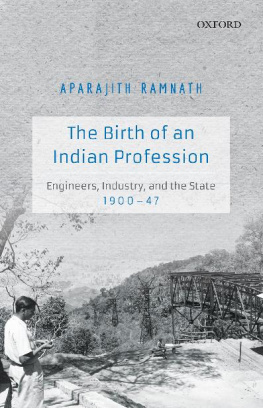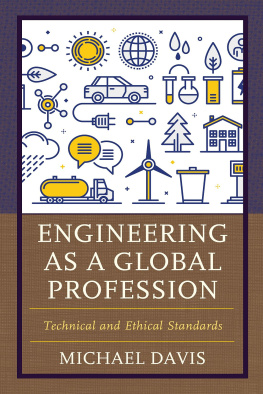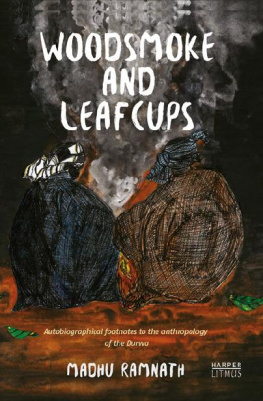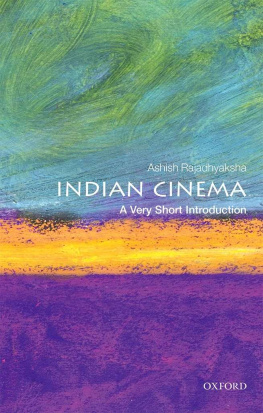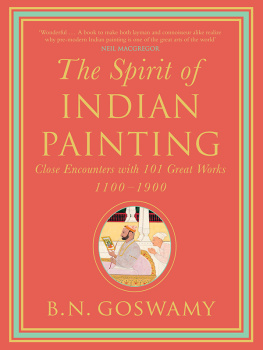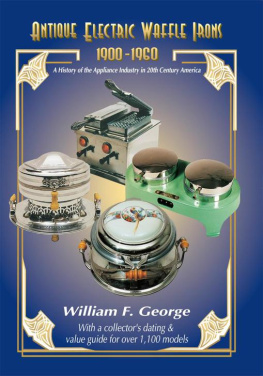The Birth of an Indian Profession
The Birth of an Indian Profession
Engineers, Industry, and the State, 190047
APARAJITH RAMNATH
Oxford University Press is a department of the University of Oxford.
It furthers the Universitys objective of excellence in research, scholarship,
and education by publishing worldwide. Oxford is a registered trademark of
Oxford University Press in the UK and in certain other countries.
Published in India by
Oxford University Press
2/11 Ground Floor, Ansari Road, Daryaganj, New Delhi 110 002, India
Aparajith Ramnath 2017
The moral rights of the author have been asserted.
First Edition published in 2017
All rights reserved. No part of this publication may be reproduced, stored in
a retrieval system, or transmitted, in any form or by any means, without the
prior permission in writing of Oxford University Press, or as expressly permitted
by law, by licence, or under terms agreed with the appropriate reprographics
rights organization. Enquiries concerning reproduction outside the scope of the
above should be sent to the Rights Department, Oxford University Press, at the
address above.
You must not circulate this work in any other form
and you must impose this same condition on any acquirer.
ISBN-13 (print edition): 978-0-19-946987-1
ISBN-10 (print edition): 0-19-946987-3
ISBN-13 (eBook): 978-0-19-909152-2
ISBN-10 (eBook): 0-19-909152-8
Typeset in ScalaPro 10/13
by The Graphics Solution, New Delhi 110 092
Printed in India by Rakmo Press, New Delhi 110 020
To the memory of
Ramchander
Jyothishmathi and Nalinikanta Rao
Visalakshi and Padmanaban
contents
This book, the roots of which lie in my PhD research, could not have been written without the support and guidance of my doctoral advisors at Imperial College, David Edgerton and Abigail Woods. They have been equally generous with advice on this book in the years after I ceased formally to be their student. I am also indebted to Sabine Clarke and Sloan Mahone at Oxford, who supported my wish to go on to doctoral work, and to Meenakshi Raman and Sangeeta Sharma at the Birla Institute of Technology and Science, Pilani, who did likewise when I first contemplated postgraduate study.
Several historians have taken time out to give useful advice and encouragement. I particularly wish to thank Ross Bassett, Pratik Chakrabarti, Ralph Desmarais, Deepak Kumar, John Bosco Lourdusamy, Yogesh Mishra, Jahnavi Phalkey, Dhruv Raina, and Waqar Zaidi. I am grateful to Ramachandra Guha for talking to me, an unknown reader who grew up on his columns, over lunch one day at the British Library, and for his subsequent advice on various matters. Colin Divall, Mark Harrison, Felicity Mellor, Andrew Mendelsohn, and Andrew Warwick, as examiners at different stages of my PhD, provided feedback that has been valuable in working on this book. Margret Frenz has been a friend and mentor for ten years now.
A book that is several years in the making requires substantial funding, and various entities have provided the necessary support. The Bharat Petroleum Scholarship, the Hans Rausing Scholarship, and a Goodenough College Bursary supported my postgraduate research. As I developed the manuscript after moving back to India, visits to the UK for further archival work were funded by the Charles Wallace India Trust and the French National Research Agency (under its project Engineers and Society in Colonial and Postcolonial India [ENGIND]). Thanks to Richard Alford, Solomon Jayasingh, Vanessa Caru, and Naziha Attia for coordinating these grants. Finally, the Indian Institute of Management (IIM) Kozhikode provided funding to attend conferences around the world where I was able to present parts of this book and related research.
For guiding me through the archives and making available the materials that form the basis of this study, although not all of it has made it into the book, I am grateful to Antonia Moon, John O Brien, and the tireless staff at the British Library, London; R. P. Narla and Deepti Sasidharan at the Tata Central Archives, Pune; Swarup Sengupta at the Tata Steel Archives, Jamshedpur; Ishwara Bhatt at BITS Pilani; R. P. Chatterjee at the Institution of Engineers (India), Kolkata; Anne Locker and others at the Institution of Engineering and Technology, London; Carol Morgan at the Institution of Civil Engineers, London; Adrian Clement and others at the Institution of Mechanical Engineers, London; Kevin Greenbank at the archives of the Centre of South Asian Studies, Cambridge; the staff at the Bodleian and India Institute Libraries at Oxford and the SOAS and Imperial College/ Science Museum libraries in London.
The institutions of St Cross College, Oxford, and Goodenough College, Londonand the many good friends I made in each placeprovided a sense of community during the earlier stages of my research, while IIM Kozhikode has been a model employer in giving me the latitude to work on my manuscript. The friendship and guidance of my fellow faculty members at the IIM have helped me settle into an academic career. I would like particularly to thank A.F. Mathew, who never tired of reminding me to work on my book; Anupam Das, who has been a great source of moral support; and the directors and deans of the Institute in the years I have worked there.
Through comments, conversations, or opportunities to present my work at various stages, many people have enriched the process of developing this book. They include Charu Singh and Mahesh Rangarajan at the Nehru Memorial Museum and Library, New Delhi; Ross Bassett at North Carolina State University and at the Society for the History of Technologys recent Annual Meetings in Albuquerque and Singapore; David Sicilia and Christina Lubinski at the World Business History Conference in Frankfurt, 2014; John Lourdusamy at IIT Madras; Bhaskar Chakrabarti at IIM Calcutta; Arvind at IISER Mohali; Nitish Nair at the Shell Technology Centre, Bangalore; Hrishikesh Chennakesavula at Ingersoll-Rand, Bangalore; Ines Zupanov, Manju Ludwig and Roger Jeffery at the 4th European South Asia PhD workshop in Heidelberg.
Joel Cabalion kindly introduced me to Roland Lardinois, from whom Vanessa Caru took up the baton to head up a project on Indian engineers, funded by the French National Research Agency. It has been a pleasure to get to know Roland and other members of the project, while I have learnt a great deal, especially about the public works engineers of Bombay Presidency, from conversations with Vanessa.
Several friends acted as foster family during my years in (and subsequent visits to) the UK. I would have been adrift without Zhiyu Chen, Xiaoyang You, Rukshan Batuwita, Shashika Subasinghe, Debapratim De, and Naina Bhattacharya. In India, friends and family in various cities put me up on my research visits, took a keen interest in my work, saved books and newspaper articles for me, and participated in many long conversations. They include R. V. S. Mani in Chennai; P. Balakrishna and Rashmi Balakrishna in Delhi; Hrishikesh Chennakesavula in Jamshedpur and Bangalore; Arnab Chakraborty in Kolkata; and R. Kumar and Usha Kumar in Pune. Anand Bhaskarans company was invaluable during an otherwise secluded year spent writing in Chennai, as was Smriti Naropanths encouragement many years ago, when book-writing was but a gleam in my eye.



